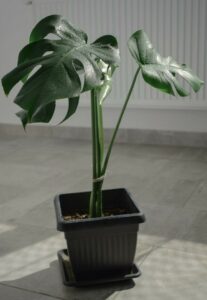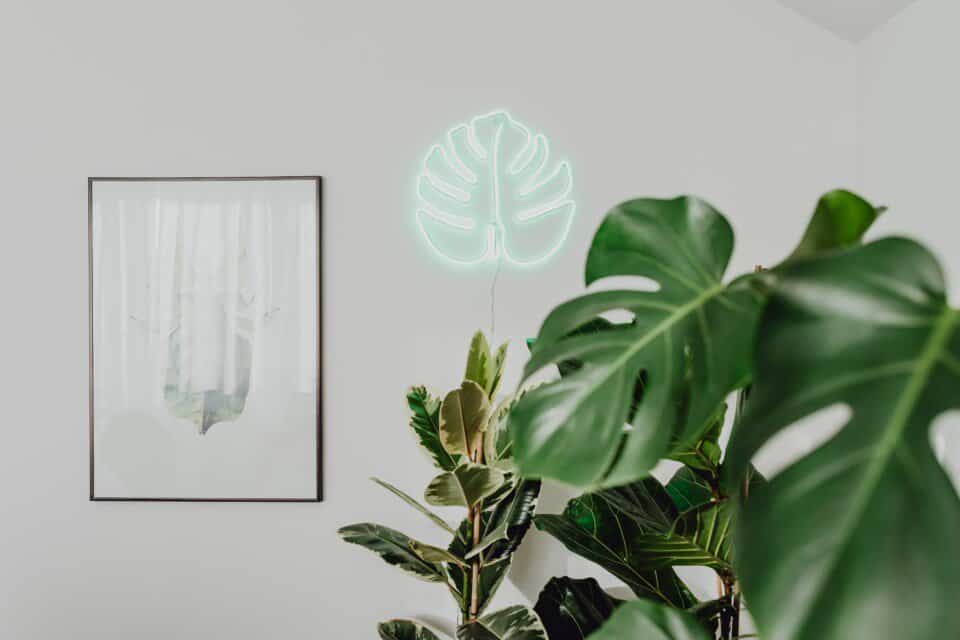Some links in the post are affiliate links and I get a commission from purchases made through some links found in the post.
It started so slowly that I almost missed it. My monstera had unfurled a new leaf which had been growing darker by the day.
I ignored it, assuming that the darkening owed to the maturity of the leaf. After all, monstera leaves start light green and become darker as they mature.
I was safe – so I thought. But something was off with this leaf. It started developing a dark hue that seemed almost black before it actually blackened.
I was unsure what to do. Should I cut off the new leaf I had awaited for so long? Should I let it be and hope that it turns back to green?
These questions ran through my mind as I sought help from more experienced monstera gardeners.
The most common reasons your monstera may be turning black is due to overwatering, underwatering and inadequate light.
Your monstera may also be turning black as a result of diseases or pests, physical harm to the leaves, or even exposure to extreme temperatures.
And when such damage occurs, the leaf is as good as dead and will not revert to its green hue.
That was a tough pill to swallow. But I learned a lot about the most common causes of your monstera leaves turning black and how you can avoid the pitfalls I wandered through at the time. Enjoy!
Why Is Your Monstera Turning Black?
 Monstera leaves turning black are not attractive as the black spots or sections interfere with the beauty of the overall plant. That’s why it’s so tempting to cut off the affected leaves and call it a day.
Monstera leaves turning black are not attractive as the black spots or sections interfere with the beauty of the overall plant. That’s why it’s so tempting to cut off the affected leaves and call it a day.
However, doing that would not help you as you would not have dealt with the causes head-on.
And as a result, another leaf would suffer the same fate, throwing you into a cycle of cutting back on your monstera leaves until the plant died.
But what do black leaves have to do with the vitality of your monstera? Well, your plant relies on its leaves to make food.
These are the chlorophyll-containing plant parts that receive photons from light and use the resultant energy, nutrients, and water to make plant food.
And without this food, the plant cannot survive, nor can it grow healthy leaves or support strong stems. Blackened leaves lack chlorophyll and thus cannot do anything to support your monstera.
If anything, the black and damaged leaves attract disease-causing microorganisms that feed on the remaining nutrients in the damaged parts.
So, having black leaves in your monstera is not just bad for the plant’s general aesthetic but also threatens its existence.
That’s why you should figure out what causes the color change and how you can avoid it for good. So, what’s affecting your monstera?
1) You Have Overwatered Your Monstera
Poor watering is often the cause of most houseplant problems. Sometimes, you give your plant too much water that it ends up suffering from the extra love.
The plant roots sit in the extra water that takes up space in the air pockets, thus depriving the roots of air. And in such an environment, root rot and other fungal diseases find it easy to attack the plant.
The damage starts at the roots, and by the time you notice warning signs, the roots have usually suffered significant damage, and repotting is often necessary.
An overwatered monstera will often show the following signs:
- The monstera may appear droopy despite having been watered. It takes on a generally limp stature and may appear soft,
- The monstera starts showing yellowing in its leaves, and
- Black spots may appear on the leaves as the fungal infestation spreads to other parts of the plant.
If you remove such a plant from its potting mix, you realize that its stems and roots have also turned mushy if root rot has ensued.
What Causes Overwatering in Monsteras?
The culprits are usually easy to figure out as they relate to how you propagate and maintain your monstera. Common mistakes include:
- Watering your monstera when the soil has not dried out,
- Leaving your monstera in a spot with low light. That forces it to reduce its photosynthesis rate, which also hurts its water absorption rate,
- Using the wrong potting mix for the monstera. If the soil mix has a high water retention rate, the plant ends up sitting in water for too long, and
- Relying on a pot with no or few drainage holes such that the excess water does not drain.
See? All these issues point to errors when handling the monstera and have little to do with the monstera.
How to Prevent Overwatering
Overwatering causes black spots in leaves and can kill your plant if left unchecked. That’s why this issue ranks first in this guide. So, how can you avoid dealing with it in the future?
- Adopt a flexible watering schedule
Rather than water the plant every few days, only water it when its soil dries out. You can check if the plant needs water by digging two inches into the potting soil and gauging how moist it is.
Often, people face an issue with this test. So, if you’re unsure if the soil is moist, you are better off not watering the plant.
Underwatering has less severe consequences, and your monstera can survive a bit of neglect.
However, if you want your monstera to thrive, you can invest in a moisture meter, as it will help you know how much moisture is in the soil at any given time.
- Cut back on watering in the colder months
Once the monstera goes dormant, do not water it much. You can water it twice each month in the winter, subject to the moisture levels in the soil.
The monstera makes little food during this time, and watering it often only forces its roots to sit in water.
- Place the monstera in a spot with adequate light
Figure out how much light your monstera needs and ensure it gets that much light. Why does this matter? Your monstera needs light, water, and nutrients to make food.
So, if it does not have enough light exposure, it does not use much of the water in its potting soil. And that results in waterlogging.
- Amend the potting soil if it has a high water retention rate
Get a soil mix that includes perlite to encourage enough drainage.
You will also need to inspect the monstera’s roots to gauge if they are in good condition.
If the monstera has suffered root damage (soft and mushy stems), you will need to cut off the damaged parts. Then disinfect the roots with a fungicide and repot the monstera in a pot of a similar size with a fresh potting mix.
2) You Have Underwatered Your Monstera
 When covering overwatering, I stated that underwatering has fewer consequences. However, this only applies when you slightly neglect your plant.
When covering overwatering, I stated that underwatering has fewer consequences. However, this only applies when you slightly neglect your plant.
If you leave it for weeks without watering it, the plant becomes dehydrated and soon starts showing the following signs:
- The plant starts wilting,
- Leaf drop may ensue,
- The plant develops browning on its leaves which can also turn crispy, and
- The browning on the monstera leaves may eventually be turning into black spots.
Reviving an underwatered monstera is often straightforward. That’s because the damage does not extend to the plant’s roots. Instead, it mainly affects the stems and leaves by interrupting turgor pressure.
What Causes Underwatering?
The causes are mostly the opposite of what causes overwatering. But it helps to zero in on what could dehydrate your monstera, including:
- Not watering the plant when its soil dries out,
- Leaving the plant in a spot with too much heat and light. These factors increase the transpiration and evaporation rates in the plant, thus robbing it of much-needed moisture,
- Using a potting mix with a low water retention rate, and
- Using a pot with too many drainage holes or with high porosity.
Can you relate to any of these issues?
Fixing Underwatering in the Monstera
Treating a dehydrated plant is relatively easy. You need to water it with warm water, allowing the excess water to drain from the pot.
Please do this for about ten minutes, then place it in a spot with bright and indirect light to allow it to absorb the water. As you move forward, you will need to:
- Adopt a regular watering schedule
If you often have difficulty remembering when to water the monstera, following a schedule could help. Figure out how often your plant needs water and aim to water it using that routine.
For example, if the soil dries out every 5 days, you can create a schedule based on this. Also, get a moisture meter to help you know when the plant needs water,
- Ensure you water your plant thoroughly such that you see the excess water draining from the pot
This ensures that every inch of the soil has moisture and reduces the rate of drying out,
- Water your plant more often in the summer when the temperatures soar
Also, move the plant away from heating vents and direct light in hot months as these factors can increase its water loss rates,
- Use a potting mix with a higher water retention rate
You can include some compost in the potting mix as this feeds the plant and ups its water holding capacity, and
- Invest in a pot that has lower porosity
That way, it does not wick away moisture from your plant, leaving it dehydrated.
Your monstera should perk up within a few days, and you can keep up the new routine to ensure it remains healthy.
3) Your Monstera Needs More Light
Lighting serves a crucial role in the growth of the monstera. The plant relies on the photons derived from light to make food.
And when it can no longer access enough of these photons, the plant cuts back on making food and lacks the energy to serve important roles. A plant in low light conditions will generally show the following signs:
- Darkening of the leaves
Low light conditions result in the loss of chlorophyll pigments. And that takes away from the color of the leaves.
Additionally, variegated monstera species can lose their variegation when placed in low light. Without chlorophyll, physiological processes in the plant suffer, and the monstera leaves can start turning black.
Let’s not forget that inadequate light is a catalyst for overwatering, where the plant faces the risk of fungal infestation,
- Stunted or slowed growth because the plant lacks adequate energy to promote healthy growth,
- Leggy growth as the plant tries to reach light from other sources, and
- The production of small leaves whose photosynthesizing efforts don’t do much to help the plant.
You will also notice that a monstera in low light will often sit in moist soil even when you space out its watering.
That’s because it does not use much of the water you give it. After all, photosynthesis takes a hit in such conditions.
Fixing Low Lighting
The easiest way to bring your plant out of this low light phase is to understand its lighting needs and provide it with the same:
- Figure out how much light your monstera needs: Monsteras usually do best with 8 hours of light. However, you may find that yours needs more than this or less than this standard,
- Understand the light exposure necessary for your monstera: While many monstera species require bright and indirect light, some do best in direct light. Thus, placing such species in indirect light would be a disservice.
- Position your monstera accordingly: Once you have understood how much and what type of light your plant needs, you can then find a good spot for it. The suggestions are as follows:
- Within 4 feet of an east-facing window for plants that need bright and indirect light or partial shade,
- Within 4 feet of a west-facing or south-facing window for monsteras that need bright and indirect light or partial sun,
- Against a south-facing window (for people in the northern hemisphere) for monsteras that need bright and direct light or full sun, and
- Within 4 feet of a north-facing window (for people in the northern hemisphere) for monsteras that need low or medium intensity light.
Interchange the south and north-facing windows based on where you live.
If your home does not have enough natural daylight to support the growth of your monstera, you can always increase its light exposure by placing it near a full-spectrum artificial light.
Be careful with the distancing as too much exposure can damage the monstera leaves.
4) Your Monstera Needs Less Light
 While poor light exposure is not suitable for your monstera, exposing it to direct and bright light is not always the answer.
While poor light exposure is not suitable for your monstera, exposing it to direct and bright light is not always the answer.
Depending on the lighting needs for your monstera, such light might be too much. And the monstera may show the following signs of distress:
- Its leaves may start browning,
- The plant may appear limp as a result of dehydration, and
- The plant may develop black spots on its leaves.
These are all signs that the heat and light have penetrated the protective barrier on the monstera leaves and damaged it. And sadly, sun damage to monsteras is not reversible.
Thus, it is always best to protect your plant from suffering such adverse changes.
How to Prevent Sunburn in Monstera Leaves
Generally, you should follow the same principles outlined under low light intensity. However, you can also take extra measures to protect your plant:
- Move the monstera to a spot that receives less light
For example, if your plant needs bright and indirect light and you have placed it in direct light, you will need to adjust its position,
- Readjust the distance to the light
Take an example of a plant that needs direct light. Instead of placing it against the southern-facing window, you can move it two feet away from the window and see how it responds.
The same goes for artificial lighting as you may need to increase the distance between the monstera and the light, especially if you are not using LED lights,
- Add a protective barrier to prevent the sun’s rays from directly hitting the monstera
You can use sheers or curtains to reduce the light exposure, and
- Change the light exposure based on the seasons.
Your monstera is likely to suffer sun damage because of exposure to summer sun which can be too much for it to handle. In such seasons, you may want to change its position.
Be careful when using artificial lighting as some lights produce light and heat, which can stress the plant. If you can, invest in LED lighting as it has minimal heat emission, which is also a plus for your utility bills.
5) Your Monstera Needs More Fertilizer
What does your plant need to make plant food? – Water, light, and nutrients! Usually, the monstera barely needs supplementation.
That’s because most people repot it every two years and offer it a fresh potting mix which it uses to survive. But sometimes, that is not enough, and the plant responds by showing these signs:
- It suffers stunted growth,
- It produces smaller leaves and weaker stems, and
- It develops black leaf spots.
You may have noticed that these signs resemble what your monstera would exhibit when left in low light conditions. So, how can you tell these issues have arisen from poor feeding?
The first way to check is by gauging how much light your plant gets in relation to how much light it needs. And the second way is by conducting a soil test using readily available testing kits in gardening stores.
How to Fix Underfeeding in Monsteras
The solution here is straightforward – you must feed your plant. However, you should avoid feeding your plant too much as excess fertilizer can burn the monstera’s roots and hamper its growth.
It could even kill the plant. Thus, you must achieve balance by:
- Using a balanced liquid 20-20-20 fertilizer with a slow-release mechanism diluted to half its strength. This feed gradually releases nutrients into the soil and does not overpower the already weak monstera. You should not expect to see results in days, but in the weeks that follow,
- Feeding your monstera when watering it to allow the plant to absorb the feed better. It also gives the plant adequate time to take in the nutrients before you flush out the excess nutrients during the next watering.
- Not feeding the plant in the winter or late fall. The monstera goes dormant in the cold months and feeding it during this time only paves the way for fertilizer burn, which can kill it. Aim to feed it from spring to early fall.
If possible, use a nutrient-rich potting mix each time you repot the plant, as this will reduce its feeding needs.
6) Your Monstera Has Suffered Temperature Stress
 Your monstera thrives in a room with an ideal temperature range, which should fall between 60 and 80 degrees Fahrenheit.
Your monstera thrives in a room with an ideal temperature range, which should fall between 60 and 80 degrees Fahrenheit.
Thus, the plant starts showing signs of distress when you fall below this level or exceed it by more than 10 degrees. Why?
When your monstera is in a spot with too much heat, its water loss rate increases. And that results in dehydration as I covered under underwatering, resulting in black spots.
And when the plant is in cold conditions, it reduces its cellular function, resulting in the bursting of cells (cell damage) which exhibits in the monstera leaves turning black.
The easiest way to gauge where the current temperature lies is by using a thermometer which gives you an accurate reading.
Dealing with Too Much Heat
If your temperatures exceed 80 degrees Fahrenheit, you can:
- Raise the humidity around the plant, which reduces the water loss rate from the monstera. Ideally, the humidity should lie between 60% and 80%. Use a hygrometer to measure the current rate, and if it is lower than this, you can increase it by:
- Adding a humidifier,
- Placing a bowl of water near the plant,
- Misting the monstera, and
- Leaving the bathroom and kitchen doors open.
- Move the plant away from heating vents as this increase the water loss rate,
- Mulch the monstera to reduce the loss of water from the soil, and
- Protect the plant with a heating pad when the temperatures become unbearable.
Like with too much light, moving your plant to a cooler spot can work the magic.
Dealing with Cold
When temperatures fall below the recommended range, frost damage can occur in the monstera leaves. In such a case, you can:
- Move the plant to a spot away from doors and windows,
- Heat the room in which the monstera grows, and
- Cover the plant with frost cloth to prevent more damage.
Also, ensure the monstera does not touch windows as this can transfer cold to the plant, thus damaging it.
7) Your Monstera Has a Pest Infestation
If the above issues are not present in your monstera, you might be dealing with pests. Common culprits include:
- Scales,
- Aphids,
- Whiteflies,
- Spider mites
You will need to inspect your plant using a magnifying lens as some of these are so small that you cannot see them with the naked eye. If pests are present, you must deal with them immediately to keep them from spreading.
Dealing with Pest Infestations
You can eliminate the pests by:
- Pruning the infested parts and discarding them far from your home, and
- Rubbing the affected parts with soapy water, neem oil, or insecticidal soap. These are natural yet effective means.
You can use synthetic pesticides or insecticides if you’re dealing with a severe infestation. These are not environmentally friendly, and you should thus reserve them for severe cases.
Should I Cut Off Black Monstera Leaves?
Black leaves serve little purpose on the monstera and can encourage disease-causing microorganisms to take up home in the plant.
Thus, I get the temptation to cut off all those black parts that do not augur well with the beauty of the monstera. But should you? Well, this is a gray area. How so?
- If the black spots and sections result from physical damage, you do not need to get rid of them. The plant can still use the green sections in the leaves to produce food and sustain its growth.
- If the black spots and sections result from diseases and pests, you should eliminate the affected parts. Otherwise, the infestation will spread to other plant parts and could kill the plant.
But how many of the affected leaves should you remove? It all depends on the severity of the damage.
If more than 50% of the plant is affected, you may need to prune one section at a time, allowing the plant to heal before moving on to the next section.
That way, you will not stress the plant too much, and it can recover in time for the next pruning session.
But if less than 50% has been affected, you can remove the black leaves at once, and the plant would still survive. Monsteras are pretty hardy.
If the black leaves do not bother you and have not resulted from an infestation, you can as well leave them on the plant.
Final Thoughts: Why is Your Monstera Turning Black?
 Whenever you see your monstera turning black, resist the urge to get rid of the affected leaves. Instead, figure out what’s causing the change and deal with it before removing the black leaves.
Whenever you see your monstera turning black, resist the urge to get rid of the affected leaves. Instead, figure out what’s causing the change and deal with it before removing the black leaves.
Better yet, ensure your plant has adequate water, light, and nutrients and leave it in a well-ventilated area to avoid dealing with your monstera leaves turning black in the future.
Happy Gardening!


